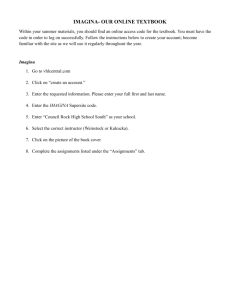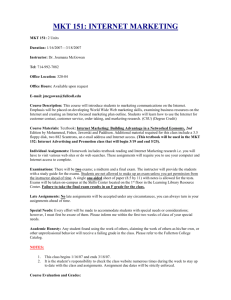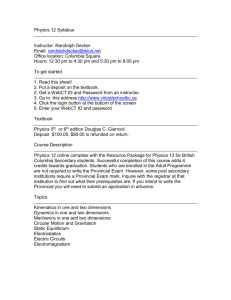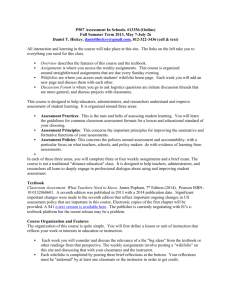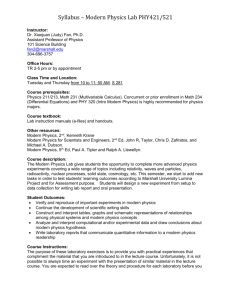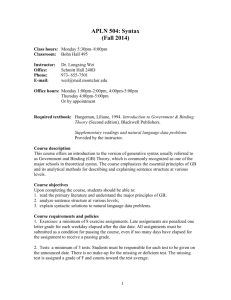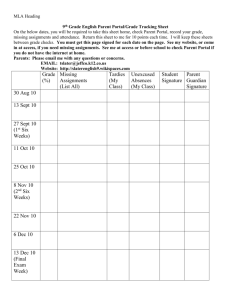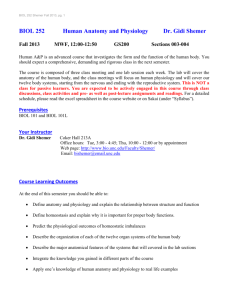Syllabi OPM3131 Introduction to Operations Management
advertisement
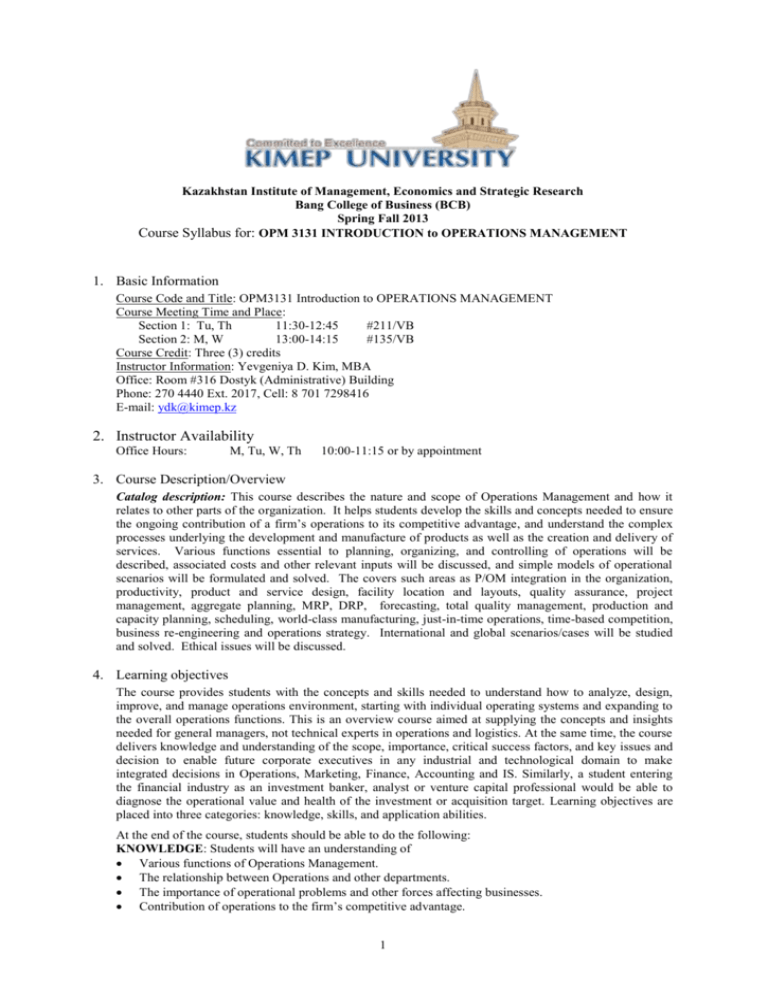
Kazakhstan Institute of Management, Economics and Strategic Research Bang College of Business (BCB) Spring Fall 2013 Course Syllabus for: OPM 3131 INTRODUCTION to OPERATIONS MANAGEMENT 1. Basic Information Course Code and Title: OPM3131 Introduction to OPERATIONS MANAGEMENT Course Meeting Time and Place: Section 1: Tu, Th 11:30-12:45 #211/VB Section 2: M, W 13:00-14:15 #135/VB Course Credit: Three (3) credits Instructor Information: Yevgeniya D. Kim, MBA Office: Room #316 Dostyk (Administrative) Building Phone: 270 4440 Ext. 2017, Cell: 8 701 7298416 E-mail: ydk@kimep.kz 2. Instructor Availability Office Hours: M, Tu, W, Th 10:00-11:15 or by appointment 3. Course Description/Overview Catalog description: This course describes the nature and scope of Operations Management and how it relates to other parts of the organization. It helps students develop the skills and concepts needed to ensure the ongoing contribution of a firm’s operations to its competitive advantage, and understand the complex processes underlying the development and manufacture of products as well as the creation and delivery of services. Various functions essential to planning, organizing, and controlling of operations will be described, associated costs and other relevant inputs will be discussed, and simple models of operational scenarios will be formulated and solved. The covers such areas as P/OM integration in the organization, productivity, product and service design, facility location and layouts, quality assurance, project management, aggregate planning, MRP, DRP, forecasting, total quality management, production and capacity planning, scheduling, world-class manufacturing, just-in-time operations, time-based competition, business re-engineering and operations strategy. International and global scenarios/cases will be studied and solved. Ethical issues will be discussed. 4. Learning objectives The course provides students with the concepts and skills needed to understand how to analyze, design, improve, and manage operations environment, starting with individual operating systems and expanding to the overall operations functions. This is an overview course aimed at supplying the concepts and insights needed for general managers, not technical experts in operations and logistics. At the same time, the course delivers knowledge and understanding of the scope, importance, critical success factors, and key issues and decision to enable future corporate executives in any industrial and technological domain to make integrated decisions in Operations, Marketing, Finance, Accounting and IS. Similarly, a student entering the financial industry as an investment banker, analyst or venture capital professional would be able to diagnose the operational value and health of the investment or acquisition target. Learning objectives are placed into three categories: knowledge, skills, and application abilities. At the end of the course, students should be able to do the following: KNOWLEDGE: Students will have an understanding of Various functions of Operations Management. The relationship between Operations and other departments. The importance of operational problems and other forces affecting businesses. Contribution of operations to the firm’s competitive advantage. 1 SKILLS: Students will learnt to Compute profits and costs, allocate resources, and forecast future trends. Do what-if-analysis. Develop simple mathematical models pertaining to operations problems. Use information systems and Decision Science tools for solving operational problems. Resolve conflicts and improve customer service. APPLICATION ABILITIES: Students will be able to Develop efficient and effective procedures and policies. Implement ethical decisions and incorporate strategies to achieve goals and objectives. Link various forces acting on and challenges facing the organization. Develop effective groups to solve operational problems. 6. Teaching (and Learning) Approach The course’s teaching approach borrows heavily from world-class business school, e.g., Harvard Business School, Wharton, Stanford, INSEAD, and MIT-Sloan, and their teaching and learning style and philosophy. The course’s key characteristics are: a) “Participant-Based Learning,” which involves interactive learning by students, both applying learned principles to real-life situations and learning from these situations; b) Small group learning, which includes preparation for class and a group project; c) In-class and at home simulations of real-life situations, including the use of Harvard Business School cases and teaching material. We will also apply the concepts and case-based learning to the different context of rapidly developing and industrializing economies, specifically Kazakhstan and Central Asia. 7. Assessment Scheme Continuous Assessment 60% Midterm (2*15%) Homework Assignment Group Case Analysis 30% 20% 10% Final Assessment 40% Project Examination (final) 20% 20% 100% TOTAL Class attendance and performance may add(deduct) 10 % o Minor modifications in the weight might be required, depending on the number of students registered for the course and their educational background. ASSESSMENT IN DETAIL Organizational Note: For group assignments and the group project, you should form groups of four (4) students. The group coordinator will submit a formal list of group membership on the 2nd week of classes to me. IT Note: Some communication and coordination can be done on-line. However, The submission of assignments must be hard copies. Use web-sites and search engines for accessing material relevant to the course and its assignments. TARDINESS POLICY: Students who are more than five minutes late will be marked absent. 8. Attached Schedule The schedule attached to this syllabus is TENTATIVE. It is subject to change during the semester due to unexpected occurrences. Instructor will give notice at least one class meeting in advance. 9. Case Analysis: A Collective Learning Exercise Case Analysis is the important component of the teaching methodology. Students will be formed into learninggroups. Students are encouraged to visit the websites of the real companies to collect up-to-date performance data. Discussion questions are either listed at the end of the case or will be supplied subsequently. Every case is an example of application of one or several concepts and theories of OM as illustrated in the textbook and the CasebookMore importantly, the case analysis should be conducted not only to answer the listed questions of the case, but also should: 2 a. Discover which issues are generic (common across the industry) in nature and which issues are specific to the case in question. b. Find out How relevant are those issues in Kazakhstan? What are the learning issues? Can the case situation be replicated in Kazakhstan? If yes - in what form; if not why not? Students are expected to present the case in a professional manner. Simple reading of the slides is not a sign of professionalism and will attract lower points. Students are expected to read the relevant chapters of textbook and casebook to understand the theoretical framework of the issues involved in the case. Students are encouraged to review other references and Internet sites to sharpen their ideas and to substantiate their arguments, but the same must be presented in their own language. Any thing that is considered as plagiarism is unacceptable. The case analysis must thrash out the critical factors of success or failures, and the learning issues that would demonstrate the intellectual abilities of the analysts. References are to be acknowledged. Students must find mutually acceptable time to discuss the case and show their work to their instructor at least two days before presenting them in the class. 10. Research Project – Exploratory Study Research outside of the class room is an important component of this course. The result of this work is a research paper on OM application topic for Kazakhstan. The orientation of the paper can be practitioner or academic. This paper can be in the form of case study, an empirical analysis, a review, or a conceptual piece. In all cases the research paper must be of publishable quality. Each project will be conducted by a group of 3-4 individuals. Students will be assigned by groups based on each having a unique and necessary skill to contribute toward the completion of the project. All members of the group are expected to contribute to the assignment. A research proposal (1-2 pages) will be due on 13th September 2013. The hard and soft copy of the research paper is to be submitted after the presentation. Students are requested to visit the web site (http://www.thewritesource.com/apa/APA.HTM) to get acquainted with the contemporary style of writing a research paper; Projects may consist of the following parts: Executive abstract Part 1. Introduction and study rationale Part 2: Literature review or theoretical considerations of the topic Part 4. Survey/Case study design (if applicable) Part 5. Analysis and discussion Part 6. Conlcusion Part 7. Written report; Part 8. Professional presentation. Project Guidelines ALL written assignments should be of the following format: 1) 2) 3) 4) 5) 6) 7) 8) 1.5 spaced One inch margins (top, bottom, left and right); Bold or underlined section headers where appropriate; Normal font sizes (12 points); Use subheadings within the report and when necessary A table of contents page is necessary Endnotes when appropriate; and No more than 25 pages (not including cover sheet, table of contents, appendix and reference section) All written submission MUST include a cover page with your name, section number, instructor’s name, and your ID number. Also, all papers should follow an accepted and consistent style. 11. Grading Scale Letter grades for the course will follow the same standards as specified in the Catalog. See the following table for grading scale: Letter grade A+ Numerical scale or percentile 90-100 3 A AB+ B BC+ C CD+ D DF 85-89 80-84 77-79 73-76 70-72 67-69 63-66 60-62 57-59 53-56 50-52 Below 50 12. Class Conducting Policies: I regard my role in the class as a coach – a though leader, inspirer and adjudicator. The core intent of this course is to inculcate creativity and to inspire students to develop the habit of “out-of-box” thinking and competencies in developing strategies to fend the competition and win the confidence of customers in a market place. I am here to help you for your learning and shaping your career advancement. Like a coach, I will push and challenge you. Copying old idea or presenting previous students’ work as yours will lead to F grade. If you want more than that you need to demonstrate creative thinking. For this you need to impress me and rest of the class. Case analysis is learning by observing and experiencing. Your assignment will provoke you to demonstrate your learning. The Does and Don’ts of the Course: 1. There will be NO make up for any exam or quiz missed. 2. Assignments are to be submitted on the due dates only. 3. You are responsible for all lecture notes and material given out in class. If you miss class, then make sure you get the notes and assignments from another student 4. NO CELLULAR OR MOBILE PHONES IN CLASS. 13. Intellectual Integrity and Honesty: Although group discussions and/or collaboration for understanding and clarification are encouraged for case analysis and projects, but individual assignments and examinations should be done by individual efforts. Any form of plagiarism or cheating behavior will result in zero points for the activity and the student(s) will be referred to the appropriate authority. 14. Tentative Session Plan No. Week 1 Sep 2-6 Week 2 Sep 9-13 Week 3 Sep 16-20 Week 4 Sep 23-27 Week 5 Sep 30-Oct 4 Week 6 Oct 7-11 Week 7 Oct 14-18 Week 8 Oct 21-25 Week 9 Oct 28- Nov 1 Week 10 Nov 4-8 Week 11 Topic Introduction to OM Introduction to Strategy. Operations Strategy OM in goods and services. Productivity The Role of Technology in Operations (ERP) New product and service development, and process selection Project Management Midterm exam Total Quality Management Statistic process control Process Strategy and Analysis Job design and work performance measurement Capacity Planning Midterm exam Location strategy Layout and Line Balancing 4 Nov 11-15 Week 12 Nov 18-22 Week 13 Nov 25-29 Week 14 Dec 2-6 Week 15 Dec 9-13 Forecasting Supply Chain Management Inventory Management Project presentations Exam week Note: Minor modifications & alteration might be required, depending on the composition & progress of the class 15. Required Textbook, Casebook and Readings: Operations Management (7th -10th ed.) by Jay Heizer and Barry Render Textbook 1 Operations Management: integrating manufacturing and services (5th edition) by Mark M.Davis and Janelle Heineke Reference Textbook 2 Operations Management (5th Edition) by Nigel Slack, Stuart Chambers and Robert Johnston, Prentice Hall Reference Textbook 3 Production and Operations Management (9th edition) by Richard B. Chase, Nicholas J. Aquilano and F. Robert Jacobs, McGraw-Hill Reading Materials Important Articles, Cases and Presentation Slides will be handed out in class in print format. 5
